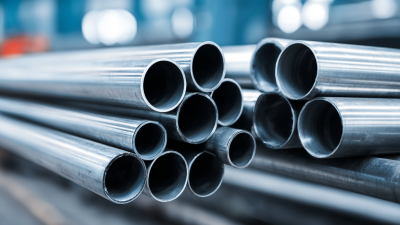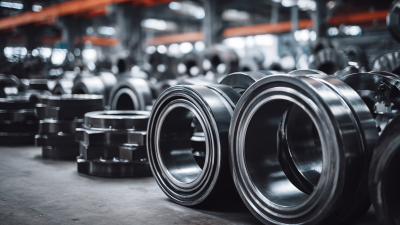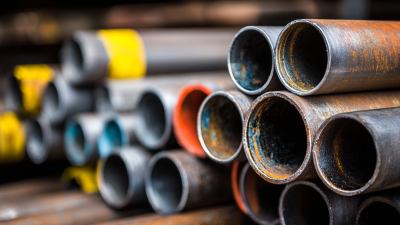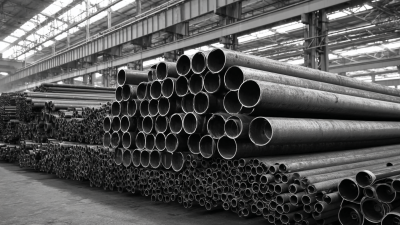Exploring the Future of Alloy Pipe Industry at the 138th Canton Fair 2025 in China
The Alloy Pipe industry is poised to experience significant growth in the coming years, as highlighted by the anticipated developments showcased at the 138th Canton Fair in 2025. According to a recent market analysis by Grand View Research, the global alloy pipe market is expected to reach USD 22.4 billion by 2025, driven by surging demand from key sectors including oil and gas, power generation, and aerospace. With the rise of advanced manufacturing technologies and the ongoing transition towards more sustainable materials, the fair will serve as a platform for industry leaders to explore innovative solutions and expand their business networks. As we delve into the future of the Alloy Pipe industry, it is crucial to understand the evolving market trends and the role of China as a pivotal player in global supply chains, particularly in meeting the increasing demands for quality and efficiency in pipe production.
Innovations and Technologies Shaping the Alloy Pipe Industry by 2025
The alloy pipe industry is poised for transformative advancements by 2025, as the 138th Canton Fair in China showcases groundbreaking innovations and technologies. Emerging trends indicate a significant shift towards using lightweight and high-strength materials, driven by the increasing demand from various sectors, including oil and gas, construction, and automotive industries. According to a recent market analysis by Research and Markets, the global alloy pipe market is projected to grow at a CAGR of 5.4%, reaching $15 billion by 2025. This growth is largely attributed to advancements in manufacturing processes and the introduction of smart technologies.
Innovations in alloy pipe production, such as the implementation of additive manufacturing and advanced coatings, are enhancing durability and reducing material waste. Furthermore, the integration of IoT with alloy pipelines is revolutionizing maintenance practices by enabling real-time monitoring and predictive maintenance. As we look ahead, companies that embrace these technologies will likely gain a competitive edge.
**Tips:** When exploring new technologies at trade fairs, focus on specific innovations that cater to your industry needs. Additionally, consider how these advancements can improve efficiency and reduce costs. Staying informed about industry reports can also help in making strategic decisions that align with market trends.
Exploring the Future of Alloy Pipe Industry at the 138th Canton Fair 2025 in China
| Technology |
Innovation Description |
Potential Impact |
Adoption Rate by 2025 |
| 3D Printing |
Utilizing additive manufacturing for creating complex alloy pipe geometries. |
Reduces waste and lowers production costs. |
30% |
| Smart Manufacturing |
Integration of IoT and AI in production processes for enhanced monitoring. |
Increases efficiency and improves quality control. |
45% |
| Corrosion-Resistant Alloys |
Development of new alloys that offer superior resistance to corrosion. |
Extends lifespan of pipes and reduces maintenance costs. |
50% |
| Eco-friendly Manufacturing Processes |
Implementation of sustainable practices in alloy pipe production. |
Minimizes environmental impact and meets regulatory standards. |
40% |
Trends in Demand for Alloy Pipes in Global Markets
The alloy pipe industry is poised for significant growth in the coming years, driven by increasing demand across various global markets. According to recent market forecasts, the global pipe support with spring market size is expected to escalate from $502.90 million in 2024 to $800.13 million by 2032, reflecting a compound annual growth rate (CAGR) of 6.01%. This trend indicates a strong push toward enhanced structural support technologies in piping systems, heightening the demand for robust materials such as alloy pipes.

Additionally, the copper tubes market is anticipated to witness remarkable expansion, surging from USD 29.14 billion in 2025 to USD 42.62 billion by 2030, with a CAGR of 7.9%. This growth is largely attributed to the increased application of copper tubes in critical industries, including construction, automotive, and manufacturing, where reliability and corrosion resistance are paramount. As demand for high-performance and durable materials rises, the alloy pipe industry is expected to adapt and innovate, continuously catering to the evolving needs of global markets.
Sustainability Initiatives within the Alloy Pipe Sector
The alloy pipe industry is increasingly recognizing the importance of sustainability, especially as it prepares for the
138th Canton Fair in 2025. Amid growing environmental concerns, manufacturers are implementing
innovative practices to minimize waste and reduce carbon footprints. Many companies are investing in the development
of eco-friendly materials and production methods that not only meet industry
standards but also align with global sustainability goals. This shift not only enhances their competitive edge but
also reflects a commitment to responsible manufacturing.
During the Canton Fair, stakeholders from the alloy pipe sector will showcase their latest sustainability initiatives,
including the use of recycled materials and energy-efficient technologies.
Industry discussions will likely center around best practices for achieving a circular economy within the sector.
By prioritizing sustainability, companies can garner support from consumers and regulators alike, ultimately creating
a more resilient and eco-conscious market for alloy pipes.
Networking Opportunities for Industry Leaders at the Canton Fair
The 138th Canton Fair in 2025 presents a unique networking opportunity for leaders in the alloy pipe industry. As one of the largest trade fairs in the world, the Canton Fair attracts numerous professionals, manufacturers, and suppliers, creating an ideal environment for forging connections. Industry leaders can engage in meaningful discussions about technological advancements, market trends, and innovative applications of alloy pipes, which are increasingly relevant in various sectors, including construction, oil and gas, and aerospace.
Moreover, the fair encourages collaboration and knowledge exchange among participants. Attendees can attend seminars and workshops focused on the latest developments in the alloy pipe industry, allowing them to gain insights from experts and thought leaders. This networking platform is essential for fostering partnerships that can drive growth and innovation, ensuring that industry players stay competitive in a rapidly evolving market. By taking advantage of these networking opportunities, leaders can not only strengthen their business relationships but also play a pivotal role in shaping the future of the alloy pipe industry.
Future Challenges and Solutions for Alloy Pipe Manufacturers
 The alloy pipe industry is poised for significant growth as highlighted by the anticipated increase in the SURF (Subsea Umbilicals, Risers, and Flowlines) market, which is projected to rise from $7,115.49 million in 2024 to $9,567.7 million by 2032, reflecting a steady growth rate of 3.8%. This upward trajectory presents both challenges and opportunities for manufacturers in the alloy pipe sector.
The alloy pipe industry is poised for significant growth as highlighted by the anticipated increase in the SURF (Subsea Umbilicals, Risers, and Flowlines) market, which is projected to rise from $7,115.49 million in 2024 to $9,567.7 million by 2032, reflecting a steady growth rate of 3.8%. This upward trajectory presents both challenges and opportunities for manufacturers in the alloy pipe sector.
As the market expands, manufacturers will face increased competition along with the need for advanced material solutions to meet evolving industry standards. Environmental regulations and the demand for sustainable practices will push manufacturers to innovate and adapt their production processes. Moreover, maintaining product quality while reducing production costs will require strategic investments in technology and skilled labor. Addressing these future challenges will be crucial for alloy pipe manufacturers to thrive in an increasingly complex marketplace.

Home
About Us
Products
Carbon & Carbon Alloy Steel
Stainless Steel
Copper & Nickel Alloy
Heat Efficiency Tubes
Pipe Fittings
Pipe Flanges
Gasket, Stud Bolt &Nut
Industrial Valves
Tech & Service
Blog
Contact Us




 The alloy pipe industry is poised for significant growth as highlighted by the anticipated increase in the SURF (Subsea Umbilicals, Risers, and Flowlines) market, which is projected to rise from
The alloy pipe industry is poised for significant growth as highlighted by the anticipated increase in the SURF (Subsea Umbilicals, Risers, and Flowlines) market, which is projected to rise from 




